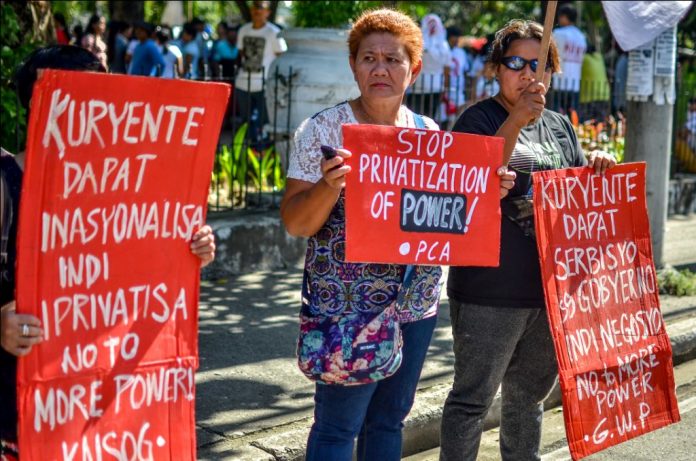
ILOILO City – Concerned electricity consumers in this southern city are questioning the capability as well as the reputation of Amador Guevarra who is being groomed by MORE Electric and Power Corp. (MORE Power) as its general manager.
Contrary to the alleged competence of Guevarra as bruited about by MORE Power, there had been reports that under his watch as manager, Pampanga Electric Cooperative, Inc. II (Pelco) incurred a P2-billion deficit which resulted to a takeover by new operators.
Pelco II was eventually managed and operated by Manila Electric Co. (Meralco) and its local partner Comstech that have to raise P1.2-billion rescue funds to partly cover the electric cooperative’s indebtedness.
Indiscriminate hiring of some 500 personnel also bugged Pelco II under Guevarra’s watch, an audit showed, even if 150 personnel were already deemed sufficient to effectively run the electric cooperative.
The Pampanga end-users’ dissatisfaction over Pelco II’s performance under Guevarra was reflected in the results of a 2014 survey covering respondents from Mabalacat City and the towns of Guagua, Bacolor, Sta. Rita, Lubao, and Porac. It suggested complaints about the company’s poor service performance and questionable billing statements.
Prior to managing Pelco II, Guevarra, known by his moniker “Ka Basil” in the underground movement, hogged the headlines in the year 2000 during the administration of then President Joseph Estrada. His group, the Rebolusyonaryong Hukbo ng Bayan (RHB), was implicated in the ambush of Estrada’s son Joel “Jojo” Ejercito and Sasmuan, Pampanga mayor Catalina Bagasina on May 23, 2000.
RHB was a splinter group of the New People’s Army (NPA), the armed wing of the Communist Party of the Philippines.
The ambush resulted to the death of DZMM radio correspondent Vincent Rodriguez and the wounding of a woman.
According to a Philippine Star report on May 30, 2000, the NPA clarified that the RHB was “no longer a part of the rebel movement and was just a band of ‘NPA expellees’ engaged in criminal activities such as extortion and looting.”
The NPA, reported the Philippine Star, also accused the RHB of being “guns for hire.”
On May 10, 2001 policemen of Guagua, Pampanga arrested Guevarra.
In what critics branded as “indecent haste,” both houses of Congress have given MORE Power the green light to replace Panay Electric Co. (PECO) which has been Iloilo City’s power distributor for nearly a century.
MORE Power, a mere spin-off from mining company More Minerals Corp., has yet to put up its own power distribution infrastructure and organize a workforce of skilled and qualified people to ensure efficient supply of electricity to its franchise area.
PECO’S CAPABILITY
As rebuttal to the previous statement of Guevarra questioning PECO’s capability, PECO corporate communications officer Mikel Afzelius responded that they are actually ranked better than the Top 20 when it is limited to only private distribution utilities (DUs).
Guevarra earlier said PECO’s rank in electric DUs is “20 out of 26” and “is not so really good.”
He also stated that PELCO II has a prestigious Category AA rank among electric cooperatives and governs a much larger franchise area.
“If we are just to limit it to private DUs then PECO is ranked around No. 10 to No. 12 out of the 26 in the country in the ERC (Energy Regulatory Commission) list which also includes economic zones,” said Afzelius.
Afzelius further cited that in the total ERC reliability ranking list, PECO only had 1,552 outage minutes for 2017 while PELCO II had 3,836 outage minutes – 2.5 times PECO’s outages in Iloilo City.
“Thus, the big gap between the two electric utilities is quite clear no matter how you look at it. By the end of 2018 our goal is to have less than 1,100 outage minutes which we are currently on track to achieve,” he added.
Afzelius also cleared that all private DUs are under the ERC and not under the Department of Energy (DOE).
“We must make it clear though that our direct regulator is the ERC. That is where we as private DUs submit our reports and accomplishments which the ERC requires from us. In fact, the ERC also regulates electric cooperatives but it’s just that the NEA (National Electrification Administration) monitors and supervises the coops,” he pointed out.
Meanwhile, further data showed electric cooperatives in Panay Island such as Capiz Electric Cooperative (CAPELCO) which is ranked No. 42 (3,112 outage minutes) and Antique Electric Cooperative (ANTECO) which is ranked No. 47 (3,556 outage minutes) fared better than PELCO II’s 3,836 outage minutes.
Both CAPELCO and ANTECO are even Category AAA electric cooperatives, higher than PELCO II’s Category AA.
Regarding systems losses, PECO’s last year was already below the ERC cap of 8.5 percent. This year, it is around 7.9 percent already which will be submitted to the ERC.
“Definitely our current systems losses are not above nine percent as alleged by MORE Power. It wasn’t even above nine percent last year. Maybe a few years back but definitely not currently,” Afzelius said.
The numbers do not lie and it is important to look at the facts versus presumptuous statements, stressed PECO.
“We can talk all we want, but in the end we need to look at the facts because you can’t really argue with factual figures that are publicly available. If something is stated, then make sure there are facts to back that up since we have to be transparent, most especially to the people we want to serve,” said Afzelius./PN





